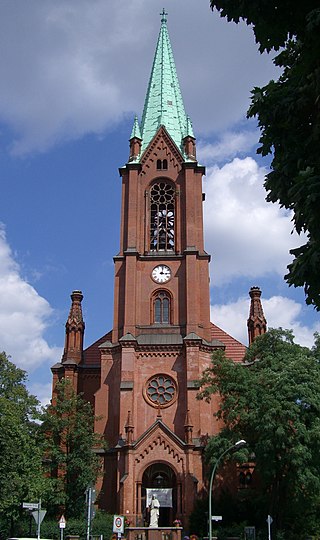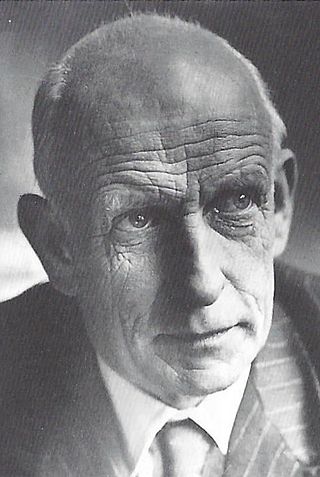
The Cathedral Basilica of the Assumption is a Gothic cathedral located in Pelplin, Poland, one of the country's largest medieval churches. A former church of the Cistercian Pelplin Abbey, it is the seat of the Roman Catholic Diocese of Pelplin. It is listed as a Historic Monument of Poland.

Gethsemane Church is one of four church buildings of the Lutheran Northern Prenzlauer Berg Evangelical Congregation, within the Evangelical Church of Berlin-Brandenburg-Silesian Upper Lusatia, an umbrella organisation which includes Lutheran, Reformed, and United Protestant Calvinist congregations.
Ludger Fischer is a German historian on building history, reviewer of contemporary architecture and political scientist.
Prestel Publishing is an art book publisher, with books on art, architecture, photography, design, fashion, craft, culture, history and ethnography. Lists range from museum guides, to encyclopaedias, art and architecture monographs to facsimile volumes and books for children.
The Kürschners Deutscher Literatur-Kalender is a reference work that currently contains around 12,000 bio-bibliographic articles and addresses of writers of German literature, as well as translators, publishers, agencies, radio stations, writers' associations, academies, literary magazines and feuilletons, literary prizes and awards in the German-speaking countries. Currently it is published every other year in two volumes by the publisher Walter de Gruyter. The reference work is named after the specialist in German studies Joseph Kürschner.

Kehrer Verlag is an art book publisher based in Heidelberg, Germany, specializing in photography, fine art, and sound art. Its books are produced in cooperation with Kehrer Design, the affiliated office for design and image processing.

Jiří Fajt is a Czech art historian living in Berlin and in Prague. From July 2014 to April 2019 he served as a Director General of the National Gallery in Prague. He is particularly interested in mediaeval and early modern arts of Central and Central-Eastern Europe. He is the author of a number of publications and successful international exhibitions.
The dtv Verlagsgesellschaft is a German publishing house headquartered in Munich. It was founded in 1960 by eleven publishers as a common paperback publishing house named "Deutscher Taschenbuch Verlag". Starting in 1996, dtv also published original editions and first editions. Since 2012, dtv has its own program with hardcover books. In 2015 the company's sales, with its 125 employees, were €65 million. dtv publishes approximately 500 new books annually. Its inventory of available titles and e-books is around 7000. In June 2015 the "Deutscher Taschenbuch Verlag" became the "dtv Verlagsgesellschaft".

The Haldensleber Roland is the Roland statue of the city of Haldensleben. The statue is the only one in Europe to show Roland on horseback. It is located in front of the town hall and represents a symbol of urban rights.
Ulrich Pfisterer is a German art historian whose scholarship focuses on the art of Renaissance Italy. He is currently a professor of art history at Ludwig Maximilian University of Munich and the director of the Zentralinstitut für Kunstgeschichte.
Peter Betthausen is a German art historian.
Richard Sedlmaier was a German art historian.
The Kürschners Handbücher, originally published by Joseph Kürschner (1853–1902), is a series of biographical reference works. Many entries are based on self information. Since the takeover by the Saur-Verlag publishing House in Munich, a self-suggestion is also possible. The series originated from Kürschners Deutscher Literatur-Kalender, which first appeared in 1879.
Robert Suckale was a German art historian, medievalist and professor at the Technical University of Berlin.
Georg Ulrich Großmann is a German art historian. He was general director of the Germanisches Nationalmuseum in Nuremberg.
Magnus Backes was a German art historian and historic preservationist. From 1983 to 1991, he succeeded Werner Bornheim gen. Schilling and Hartmut Hofrichter as the third Landeskonservator of the General Directorate for Cultural Heritage Rhineland-Palatinate Rheinland-Pfalz in Mainz.

Ernst Emil Max Gall was a German art historian and historic preservationist.
Heribert Reiners was a German art historian and academic teacher at the Universities in Bonn and Fribourg.
The Fachbuchverlag Leipzig was an East German publisher. It continues to exist as an imprint of the Munich publishing firm Carl Hanser Verlag.
Edition Leipzig was a publisher in the German Democratic Republic (GDR/DDR), which, for the most part, placed books on Western markets as an export publisher. This was intended to serve representative purposes as well as to procure foreign currency. Today, the publishing house is part of the Seemann Henschel publishing group, which was taken over by Zweitausendeins in October 2017 with a program on regional and cultural history.





